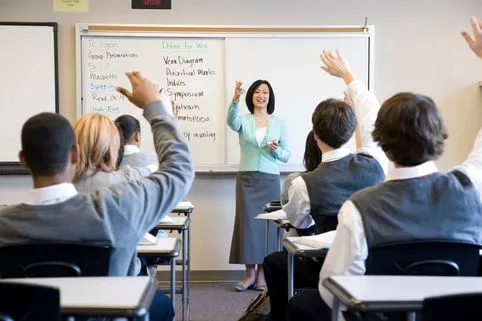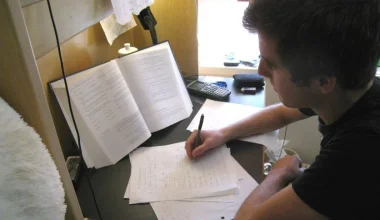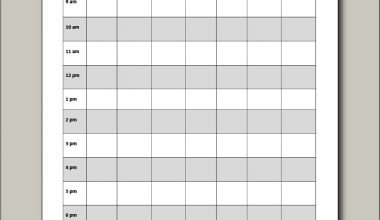What is the average class size secondary UK? Knowing that the number of students learning at one time significantly impacts their learning experience. Even secondary schools adhere to the teacher-to-student ratio due to its importance.
The average class size of secondary schools in the UK is a major consideration for both private and public schools.
As a guardian or student, you must find the school that meets your learning needs. While some may be slightly above the benchmark, others may just be below it.
This article explains class size and its importance to students’ learning experience. If you wish to study in the UK, you will gain deep insights into the average secondary class size.
Table of Contents
- What are Class Sizes in UK?
- What Are The Average Class Sizes in the UK?
- Average Class Size in UK | Primary Schools vs. Secondary Schools
- What are School class sizes in the UK?
- What is the Maximum Class Size in Secondary Schools UK?
- What is the average class size of an English Secondary School?
- What are Sixth Form College Class Sizes?
- What is the average class size in Private Schools in the UK?
- What is the Maximum class size in Secondary School UK
- Conclusion
- References
- Recommendations
What are Class Sizes in UK?
Class sizes refer to the number of students enrolled in a particular class. This statistic is important as it directly affects the student-teacher ratio.
Also, it subsequently influences the level of individualized instruction each student receives.
The smaller the class size, the more impact the learning experience. However, resources and time may not allow one student to be a teacher at every learning point.
Hence, class sizes come in handy to foster a conducive environment for questions and discussions. In fact, they allow for a deeper understanding of the subject matter.
Generally, the average class size is influenced by factors like funding, school policies, available infrastructure, and teaching resources.
Read Also: Is Dual Enrollment Hard In High School? How To Take Classes
What Are The Average Class Sizes in the UK?
The average class size in UK secondary schools has been a subject of interest and discussion. These class sizes are significant in determining the quality of education and the learning experience for students.
According to a publication on Guardian.com, official data from the Department for Education (DfE) shows that secondary school rolls increased by 81,000 pupils at the start of the academic year, pushing the average class size to 22 and the average size of a secondary school up 2% to 986 pupils.
In 1998, the School Standards and Framework Act limited the number of students in a class to 30. This suggests that any class larger than 30 pupils must have another teacher.
Let’s explore some factors that may influence the size of a class:
Average Class Size in UK | Primary Schools vs. Secondary Schools
On average, primary schools tend to have smaller class sizes than secondary schools.
This is often because primary schools emphasize foundational learning and benefit from smaller student-teacher ratios, allowing for more personalized attention.
In 2022, the average primary class size increased to 26.7, from 26.6.
Public vs. Private Schools
Private schools in the UK often have the advantage of setting their class sizes. As a result, they may maintain smaller class sizes to provide more individualized instruction.
Public schools, on the other hand, might have larger class sizes due to budget constraints and higher student populations.
Read Also: Public vs. Private College: Which is Better?
Urban vs. Rural Schools
Urban schools in densely populated areas might experience larger class sizes due to higher student populations.
In contrast, rural schools might have smaller class sizes due to lower student numbers and a more community-oriented approach.
Read Also: What AP Classes Should I Take? Guide To Pick The Right AP Classes.
What are School class sizes in the UK?
School class sizes aim to provide high-quality education that equips students with the skills they need to succeed academically and personally.
The concept of school class size refers to the number of learners attending a school lesson. This may vary depending on the educational level and subject being taught.
The size of a school class plays an important role in determining the number of teachers required to monitor the students. In the United Kingdom, an average primary school would need one teacher for every twenty pupils.
Hence, two teachers would be necessary for a classroom of thirty students. Most UK primary schools have about 26.7 pupils per class.
Read Also: 10 Benefits of Taking AP Classes in High School | Pros and Cons
What is the Maximum Class Size in Secondary Schools UK?
No laws currently dictate the maximum class size for post-primary education students aged 11 to 18.
However, some regulations limit the number of pupils per teacher to 20 in practical subjects. Practical subjects include science, technology and design, home economics, art and design, physical education, and music.
However, there are exceptions and certain circumstances where this limit can be exceeded. These circumstances might include:
- Exceptional Circumstances: In some cases, schools might be allowed to exceed the 30-student limit if there are exceptional circumstances, such as a lack of available classrooms or unforeseen spikes in student enrollment.
- Special Education Needs: Schools that have students with special educational needs might have slightly smaller class sizes to provide more individualized support.
- Post-16 Education: Class sizes for students aged 16 and above (post-16 education) can vary more widely. The regulations for post-16 class sizes are often different from those for students in key stages 3 and 4.
Read Also: What are Hybrid Classes and How Do They Work? Is it Worth it?
What is the average class size of an English Secondary School?
The most accurate and current information on the average class size of English secondary schools can be found in official educational sources, local school districts, or the Department for Education in England.
However, the average class size of an English secondary school can vary based on several factors, including the region, type of school (public or private), and the specific grade level.
On average, class sizes in English secondary schools often range from around 25 to 30 students per class. These numbers are approximate averages and can vary from school to school. Some schools might have slightly smaller classes, while others might have larger classes, especially in densely populated urban areas.
In the UK, state-funded schools have guidelines and regulations regarding class sizes. The legal limit for key stages 3 and 4 (ages 11 to 16) is typically set at 30 students per class. However, schools may apply for exceptions under certain circumstances.
What are Sixth Form College Class Sizes?
The class sizes in sixth form colleges in the UK can vary based on different factors, including the specific college, the courses offered, and the resources available.
Generally, sixth form colleges tend to have smaller class sizes than secondary schools, as they cater to students in their final two years of pre-university education.
On average, class sizes in sixth form colleges range from around 10 to 20 students per class. This smaller class size allows for more personalized attention, focused discussions, and closer interactions between students and teachers.
For the most accurate and up-to-date information on class sizes at a specific sixth-form college, it is recommended to contact the college directly.
What is the average class size in Private Schools in the UK?
The average class size in private schools in the UK tends to be smaller than in public (state-funded) schools. Private schools often emphasize providing a more personalized education, and smaller class sizes are one way they achieve this.
Class sizes in private schools in the UK can vary, but they often range from around 15 to 20 students per class.
The average class size in private schools in the UK is 16. This smaller class size allows for more focused teacher-student interactions, customized instruction, and a closer sense of community within the school.
However, Some schools might have slightly larger or smaller classes based on their teaching philosophies, available resources, and student enrollment.
What is the Maximum class size in Secondary School UK
In England and Wales, classes at Key Stage 2 (KS2) and higher are not currently subject to a class size limit. KS1 students are subject to a statutory maximum for class sizes in baby courses.
Frequently Asked Questions
Government funding and regulations can play a significant role in determining the optimal class sizes for schools.
Smaller class sizes can provide more individualized attention, but larger classes can promote diverse perspectives and collaborative skills.
Government funding and regulations can play a significant role in determining the optimal class sizes for schools.
Class size standards vary globally due to cultural, economic, and educational differences among countries.
There are 1,657,000 in primary schools and 1,669,000 in secondary schools.
The average size of a class in the UK is 25.
Conclusion
The average class size of secondary schools in the UK remains a multifaceted issue with far-reaching implications.
Striking the right balance between class size, educational quality, and individualized attention is a challenge that requires ongoing collaboration between stakeholders.
By understanding the various factors influencing class sizes and their impact, we can work towards creating an educational environment that empowers every student to succeed.
References
- Think Student.co.UK – What Are The Average Class Sizes in the UK?
- explore-education-statistics.service.gov.uk ____ Schools, pupils and their characteristics
- nasuwt.org.uk _____ Class Sizes






